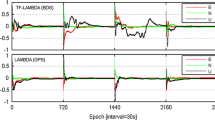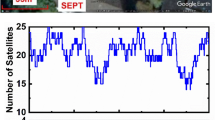Abstract
The recent GPS Block IIF satellites SVN62 and SVN63 and the Galileo satellites GIOVE-A, GIOVE-B, PFM and FM2 already send signals on more than two frequencies, and more GNSS satellites will provide tracking data on at least three frequencies in the near future. In this paper, a simplified general method for ambiguity resolution minimizing the noise level for the triple-frequency geometry-free (GF) and ionosphere-free (IF) linear combinations is presented, where differently scaled code noise on the three frequencies was introduced. For the third of three required linear combinations, the most demanding one in triple-frequency ambiguity resolution, we developed a general method using the ambiguity-corrected phase observations without any constraints to search for the optimal GF and IF linear combination. We analytically demonstrate that the noise level of this third linear combination only depends on the three frequencies. The investigation concerning this frequency-dependent noise factor was performed for GPS, Galileo and Compass frequency triplets. We verified the theoretical derivations with real triple-frequency GPS and Galileo data from the Multi-GNSS Experiment (M–GEX) of the International GNSS Service (IGS). The data of about 30 M–GEX stations around the world over 11 days from 29 April 2012 to 9 May 2012 were used for the test. For the third linear combinaton using Galileo E1, E5b and E5a, which is expected to have the worst performance among all the GNSS frequency triplets in our investigation, the formal errors of the estimated ambiguities are in most cases below 0.2 cycles after 400 observation epochs. If more GPS satellites sending signals on three frequencies or more stations tracking Galileo E6 signal are available in the future, an improvement by a factor of two to three can be expected.







Similar content being viewed by others
References
Cocard M, Bourgon S, Kamali O, Collins P (2008) A systematic investigation of optimal carrier-phase combinations for modernized triple-frequency GPS. J Geod 82(9):555–564. doi:10.1007/s00190-007-0201-x
Feng Y, Rizos C, Higgins M (2007) Multiple carrier ambiguity resolution and performance benefits for RTK and PPP positioning services in regional areas. In: Proceeding ION GNSS, Fort Worth, TX, USA, 25–28 Sept 2007, p 668–678
Gurtner W (2007) RINEX: The Receiver Independent Exchange Format Version 3.00. http://epic.awi.de/29985/1/Gur2007a.pdf
Hatch RR (2006) A new three-frequency, geometry-free, technique for ambiguity resolution. In: Proceeding ION GNSS, Ft Worth, TX, USA, 26–29 Sept 2006, p 309–316
Henkel P, Günther C (2010) Reliable integer ambiguity resolution with multi-frequency code carrier linear combinations. J Glob Pos Sys 9(2):90–103. doi:10.5081/jgps.9.2.90
Henkel P, Günther C (2012) Reliable integer ambiguity resolution: multi-frequency code carrier linear combinations and statistical a priori knowledge of attitude. J Inst Nav 59(1):61–75. doi:10.1002/navi.6
Januszewski J (2011) Satellite Navigation Systems, Data Messages, Data Transfer and Formats. In: Modern transport telematics: 11th International Conference on Transport System Telematics, TST 2011, Katowice-Ustroń, Poland, 19–22 Oct 2011, p 338–345 doi:10.1007/978-3-642-24660-9_39
Li B, Feng Y, Shen Y (2010) Three carrier ambiguity resolution: distance-independent performace demonstrated using semi-generated triple frequency GPS signals. GPS Solut 14(2):177–184. doi:10.1007/s10291-009-0131-6
Li J, Yang Y, Xu J, He H, Guo H (2012) Ionosphere-free combinations for triple-frequency GNSS with application in rapid ambiguity resolution over medium-long baselines. Proc China Sat Nav Conf (CSNC) 2012:173–187. doi:10.1007/978-3-642-29175-3_16
Inside GNSS (2012) First acquisition and tracking of IOV Galileo signals, vol 7, p 46–55. ISSN:1559–503X
Noll C, Bock Y, Habrich H, Moore A (2009) Development of data infrastructure to support scientific analysis for the international GNSS service. J Geod 83(3–4):309–325. doi:10.1007/s00190-008-0245-6
Weber R (2012) IGS M-GEX - The IGS Multi-GNSS Global Experiment. Wksp on GNSS Biases, 18–19 Jan 2012, Bern, Switzerland. http://www.biasws2012.unibe.ch/pdf/bws12_2.3.5.pdf
TLE (2012) Two line element set for Galileo satellites. http://www.celestrak.com/NORAD/elements/galileo.txt
USNO(2012) Block II satellite information. United States NAVAL Observatory (USNO). ftp://tycho.usno.navy.mil/pub/gps/gpsb2.txt
Wang Z, Liu J, Zhang K, (2004) Multiple carrier ambiguity resolution method for Galileo. In: Proceeding (2004) International Symposium GNSS/GPS. Australia, Sydney
Acknowledgments
This work was funded by ESA as part of the project (Satellite and Station Clock Modeling for GNSS, Reference: AO/1-6231/09/D/SR). We would like to thank M. Müller from the Institute of Geodesy and Photogrammetry, Eidgenössische Technische Hochschule Zürich (ETHZ) for processing the Galileo Two Line Element Set (TLE) (TLE 2012) and T.S. Kelso from CelesTrack for providing TLE of the four Galileo satellites (GIOVE–A, GIOVE–B, GALILEO–PFM and GALILEO–FM2) for the time interval April 29, 2012 to May 9, 2012. We also want to thank IGS for providing triple-frequency M–GEX data on its archive (ftp://cddis.gsfc.nasa.gov/pub/gps/data/campaign/mgex/).
Author information
Authors and Affiliations
Corresponding author
Rights and permissions
About this article
Cite this article
Wang , K., Rothacher, M. Ambiguity resolution for triple-frequency geometry-free and ionosphere-free combination tested with real data. J Geod 87, 539–553 (2013). https://doi.org/10.1007/s00190-013-0630-7
Received:
Accepted:
Published:
Issue Date:
DOI: https://doi.org/10.1007/s00190-013-0630-7




